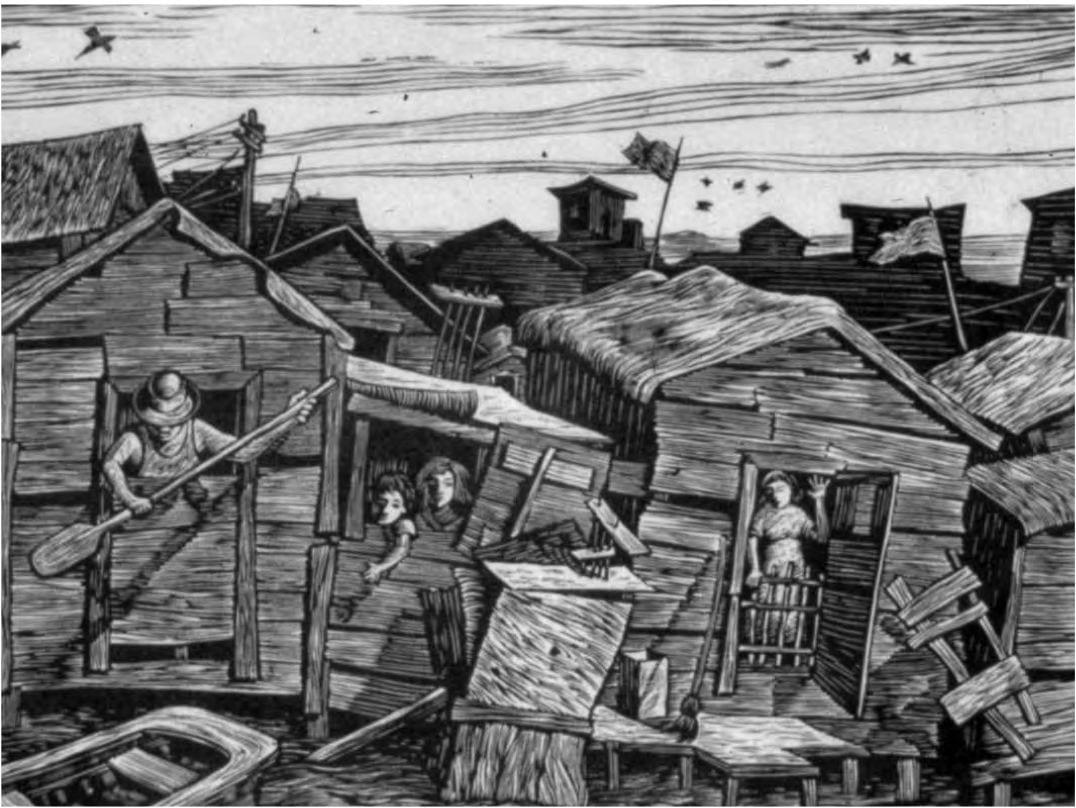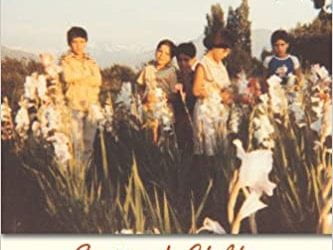Inequality in Puerto Rico
Facing the Challenges

Carlos raquel rivera, Marea Alta, 1954, linoleum, 12″ x 16″. Collection Museum of history, Anthropology and Art, university of Puerto rico, rio Piedras Campus. hurricanes often reveal the social fissures in the society.
When Hurricane George ravaged Puerto Rico in 1998, it also blew apart Puerto Ricans’ shared perceptions of relative well-being based on a narrative of quasi-linear economic, political and social progress. Hurricanes, earthquakes and tornados often force societies to confront themselves and their social inequalities. Such was the case in Puerto Rico. In some neighborhoods, people had almost immediate access to potable water; in others, there was nothing to drink for days. In some communities, generators and other resources helped with lack of electricity; poor people experienced long blackouts. After the initial cleanup, it also became apparent that some people would have a relatively easy time in finding ways to reconstruct their homes; others remained displaced. These different experiences challenged collectively shared framings of social identity.
What seemed to be peering out from this set of circumstantial pieces of evidence was the fragility of economic progress and the underlying nature of social and economic differences, generally hidden behind highways, public construction works, and the collective obsession with the question of Puerto Rico’s political status. Georges rendered apparent the geographic contiguity of gaping social and economic distances in resources and opportunities. Facts that had been tucked away in published academic journals over various decades of research, produced with statistically complicated techniques, had become concrete in the experience of an ecological disaster.
Two recent publications on Puerto Rico’s economy (the Brookings Institute Restoring Growth and the CEPAL (ECLAC) Study on Puerto Rico’s Economy) have rendered a more or less shared assessment of Puerto Rico’s economic condition. These studies point out three main issues: the condition of Puerto Rico’s labor markets, its stagnant growth and the relative weakness of the private sector. As the CEPAL study points out, private sector weakness is reflected both in low entrepreneurial initiative and, historically, a tendency toward weak employment creation. In a certain sense, inequality is seen merely as a consequence of these dynamics. However, social and economic inequality in Puerto Rico are, if anything, at the root of many of its ailments. In Puerto Rico, there is little social mobility, and that could be a factor in social and economic inequality, although that relationship is difficult to document. More importantly, long-standing difficulties in the formulation of a societal consensus around a given political direction have a plausible, albeit indirect, association with inequality in Puerto Rico.
Characteristics of Social Inequality
Inequality in Puerto Rico has been comparatively high since the early days of its industrialization. Inequality in a strict sense simply refers to relative position on a distribution of resources. Social scientists trying to grasp the nature of social equality generally analyze who has how much and why. They ask how much a given person—from a given social class, male or female, and belonging to a particular regional, racial or ethnic group—has relative to others in the same type of group. Household income inequality indicates distribution of resources in the most aggregate sense. This measure, which includes pre-tax sources of income, suggests that inequality in Puerto Rico has changed over time by small amounts around a relatively high threshold.
In terms of the tendencies of aggregate inequality, Puerto Rico’s inequality patterns have shifted around since the beginning of its development period when inequality by this measure was probably at its peak. In 1969, aggregate household inequality was about 57 percent on the GINI scale. It shrunk to its lowest in 1989 (to 51). However, recent census data shows that inequality is again on the increase. Using this data, it appears that inequality is now back to where it was in the late 60s.
The CEPAL (ECLAC) study finds that U.S. federal transfers to the poor are a mitigating factor in Puerto Rico’s poverty and inequality. It also finds that the poor are generally associated with those who have no declared jobs in the census. Thus, the history of weak employment creation associated with the island’s development partially accounts for the position of the poor in Puerto Rico. While federal transfers might mitigate inequality at the bottom of the distribution, any shift in the role of factors affecting the real earnings of those employed will intensify inequality patterns. But this seems to explain marginal shifts in the context of an already highly unequal distribution.
Household income inequality has changed over time by small amounts around a relatively high threshold. In the 1950s, aggregate household income inequality hovered around .44 on the GINI scale (Orlando Sotomayor, 2004:1397-1398). This meant that the poorest 20 % accounted only for around 5.6 % of all income, while the richest 20 percent controlled about 50.4 %. While living standards have risen considerably since the 1950s, inequality patterns worsened with industrialization (1950 to 1979), improved mildly in the 1980s, but worsened dramatically in the 1990s. While the pie has increased over time, shares have actually remained constant or declined for all but the households in the top 20 % of the income distribution. The top quintile of all households obtained about 60 percent of total income. (CEPAL, 175-176). In 1999 aggregate household inequality hovered at around .558 on the GINI scale according to Sotomayor’s research.
Puerto Rico has higher levels of household inequality than some of the poorest states in the United States where inequality is lowest relative to the more industrialized states of the Northeast. For example, Puerto Rico’s aggregate income distribution in 1999 (w. a GINI coeff. of .56) was more unequal than that of West Virginia, the poorest state (w. a GINI coefficient of .44), and more unequal than the District of Columbia or the state of New York. Aggregate inequality in Puerto Rico resembles patterns found for other developing countries. Puerto Rico in the late 90s was comparable in its aggregate inequality to other Latin American countries with which one would not generally find Puerto Rico in the same breath, such as Brazil. It is startling that Puerto Rico has a GINI coefficient of .57, while Brazil is only slightly worse off, ranked at .60 respectively (CEPAL: Table 87, pg 179). Census data for 2005 suggests that household inequality in Puerto Rico has inched slightly downward to .53 on the GINI scale.
Labor Markets
Labor market earnings reflect wide disparities as well, both at a fixed point in time and over time. For example, the ratio of average to median earnings (a gross approximation to the degree of inequality in the labor market) was about 1.3 in 1969, when data on the subject first became available. However, since 1969 was the tail end of the peak of Puerto Rico’s industrialization, such a gauge reflects an already widened distribution of earnings owing to the industrialization process itself. While earnings inequality declined in the 1970s with the recession, it returned during the 80s and 90s to its previous levels, to reach 1.54 in 1999. This increase in the spread of earnings is a function of the increase in the average earnings of those regularly employed, which increased from $11,800 in 1969 to about $20,000 in 1999. The median however, (reflecting the earnings of those who are just on the 50th percentile) stayed largely in place hovering between $9,000 and $10,000 for the better part of thirty years (1969-89). When segmented by quintiles, it becomes obvious that inequality patterns observed for households also hold for the labor market. In essence, top earners (those at the top 20 % of the distribution) have actually increased their share of all earnings from 48 % in 1969 to about 52 % in 1999. Such a rise in inequality has happened at the expense of almost everyone. The exception is the lowest 20 % who have maintained a share of earnings at a steady 4.3 %.
These patterns hold true by education thresholds as well. While returns to education increased during the 80s, inequality has not only widened across education thresholds but also within them. This however is not true for the entire period. For example, college-educated workers used to make about 3.4 times the earnings of workers who never entered high-school in 1969. By 1999 the disparity was about 2.5. This disparity has shrunk because as the least educated workers have become a smaller proportion of the working population their earnings have actually increased by a wider margin up to 2.6 times what they used to be in 1969. For college-educated workers, average earnings have increased by 1.6 times their value in 1969. Most affected have been those workers with a high school education. While their annual earnings were above the average in the 1960s, their position has deteriorated in absolute terms through the 80s and only improved marginally during the 90s. Nowadays, they earn only 85 percent of the average annual earnings, whereas in the late 60s workers with a high school diploma earned approximately 115 percent of annual earnings. Thus, those at the bottom are fewer with stagnant earnings, while the most highly educated have actually gained in recent years, especially when compared to those with just a high school education. Most of this change took place during the 90s. This process is not one of polarization since that would involve a thinning of the middle and a thickening of the bottom and the top of the distribution. Rather, the evidence seems to reflect an underlying re-structuring that favors those already at the top of the distribution. Generally, such dynamics have been associated with an increasing jobs-skill mismatch.
Industrial Re-structuring and Occupational Re-Composition
The labor market in Puerto Rico is changing, and that change does not favor those with little education. In 1970, the most common occupations involved working in the garment and textile industries as sewers, embroiderers, tailors, and dressmakers. Over the next thirty years, the occupational structure diversified and experienced a general, albeit slow, upgrading in the status of jobs. By 1999, the most common occupations were secretarial and administrative assistants. Together with janitors (a position of low occupational status), these occupations comprised about 9% of the adult work force (ages 20-59).
If occupational status is segmented by education the difficulties of the bottom-end of the labor market become readily apparent. In 1969, about 4% of high school drop-outs had positions as managers. By 1980, this share of managerial positions dropped to 1.8 %. Thus, those with some high school education found themselves taking jobs such as cooks and building caretakers that had traditionally been the arena of those with no high school. In the area of top-ranked occupations, the upgrading of jobs seems to have changed very little as well. For example, in 1969, the top-ranked occupations with the most people employed were mid- to low-level managers, typists and teachers. By 1999, the most common top-ranked occupations were teachers, along with a greater variety of professional positions such as accountants, supervisors and managers—occupational groups not much different from those found thirty years earlier.
Other Resources
Patterns in the labor market might be amplified by wealth garnering mechanisms that were previously not available to households. “Other” sources of income are now more highly correlated with the size of a household’s income than had been the case thirty or forty years ago. The data available for such a conclusion is merely suggestive. This is an area in which very little is actually known. But data from the U.S census on the correlation of non-earned income with total household income suggests an increasing positive correlation of household income with “other” income resources such as interest and pension income. Among households in Puerto Rico the correlation of “other” income sources with household income was around 8% in 1970. By 1990 total household income had a correlation of 15 percent with interest income, of 3 percent with retirement income and of 3 percent with other income. For those in the top 20% of the distribution, household income was positively correlated with interest income at 17 %. In 2000, the correlation of income from interest with the size of household income ascended to 21 %, and that of “other” sources ascended to 5%. While the increasing association of higher incomes with non-earnings sources is not definitive evidence, it suggests an increasing relevance of other sources of income not related to the labor market as a source of position for households. Such a trend very likely reinforces the structural position of those already privileged by better positions in the labor market, and higher and better quality education. Thus, increasingly disparate endowments of resources widen an already unequal access to a vast array of social and cultural capital required for successful attainment in the labor market.
Education has in fact operated to mitigate pre-existing inequalities. K-12 education has been largely public and of relatively high quality when compared to other countries (the public-private ratio and the quality of public education have worsened recently). The expansion of higher education has a more controversial role. In the 60s some research argued that, contrary to popular perceptions, the expansion of public higher education and the role of the Universidad de Puerto Rico (UPR) as a public institution did not mitigate inequality, nor did it alter the rates of access of socially privileged sectors to higher education (see for instance the work of Luís Nieves-Falcón). In other words, patterns of social mobility did not change with the expansion of higher education. If this was true then, it is even more so now.
Finally, mechanisms that operate to mitigate inequality-inducing features of the labor market have plausibly had the opposite effect, worsening pre-existing inequality. Here various aspects of government policy come together to affect observed inequality. For instance, the state-side tax framework has been found to be regressive in its distributional effects. This is largely a function of the way in which it is implemented, not of the nature of its design. Another example is an industrialization policy that has not stimulated effectively the creation of jobs for a broad swath of the population seeking and needing higher-end employment. In recent years, a zero-growth scenario coupled with inflation has quite plausibly amplified inequality and even worse, might have worsened living standards.
These patterns of inequality are replicated in many other ways. Geographically, municipalities around urban areas have higher per capita incomes than those in the historical hinterland. For example, Guaynabo, the municipality with the highest income per capita, had about 3.27 times the per capita income of Adjuntas, the poorest municipality in 1999. Although these geographic differences have been shrinking over time partly owing to out-migration from rural to urban areas, their persistence speaks to a historical record of lopsided conditions that used to favor urban areas both in the expansion of education and in the location of industrial development.
What is To Be Done?
Puerto Rico has entered the 21st century facing a crossroads. Some of the mechanisms for economic stimulus and development that its political class had relied on have been eliminated by the U.S. Congress. Others have been rendered irrelevant by the re-positioning of Puerto Rico in the global economy. The insular government had once directed a relatively coherent development program with muscular agencies committed to the formulation of a path out of stagnation and poverty. Now government is considered at best an obstacle and at worst culprit of the slow growth and of the inefficacious educational system that seem to hamstring the Island. While there are no easy solutions various policy options could aid in mitigating trends in inequality. First, a state-side earned income credit would improve the condition of the working poor, thereby mitigating inequality in the labor market. While a recently implemented consumption tax, labeled the IVU, was largely deemed regressive, there is no reason why a consumption tax could not be structured to have progressive re-distributive consequences, with a possible inducement to savings and local capital build-up. Finally, policies directed at institutional factors require long-term plans. A new industrial policy cannot simply stimulate the high-end of the job market. It must address the slow growth of jobs particularly in the middle range of the labor market. It should not take another hurricane like Georges to draw attention to the huge inequalities in Puerto Rico. Puerto Rico and its government must face the challenge now.
Spring 2008, Volume VII, Number 3
Harold Toro is a Postdoctoral Fellow at the Weatherhead Center for International Affairs. He received his PhD in Sociology at the University of California, Berkeley in 2007. This article condenses some of the findings and analyses from his dissertation: Economic Development and Labor Market Inequality in Puerto Rico. His research examines the interplay between economic development, demographic change and social stratification, with a focus on Latin America and the Caribbean. He has also written on the stratification consequences of educational expansion in Puerto Rico during the initial period of U.S. colonial control, and on gender inequality among small businesses in the United States. Currently, he is working on projects focused on inter-generational occupational attainment in Brazil and on urban poverty in Mexico.
Related Articles
Santiago’s Children
There are five reasons I jumped at the chance to write a preface to Steve Reifenberg’s memoir about living and working in the early 1980s in a home for Chilean children who would otherwise…
Crossings: Photographs From the U.S.-Mexico Border
While photographing in areas of the Amazon, Alex Webb felt as if he “had stepped into the setting of a Mario Vargas Llosa or Gabriel García Márquez novel because of the sense of magic…
Making a Difference: The Bolivian Street Children Project
At 12,000 feet, you can feel the effects of the altitude every step you take. But a group of seven women from Harvard did not let that stop them from two months of in-depth work in the world’s…




